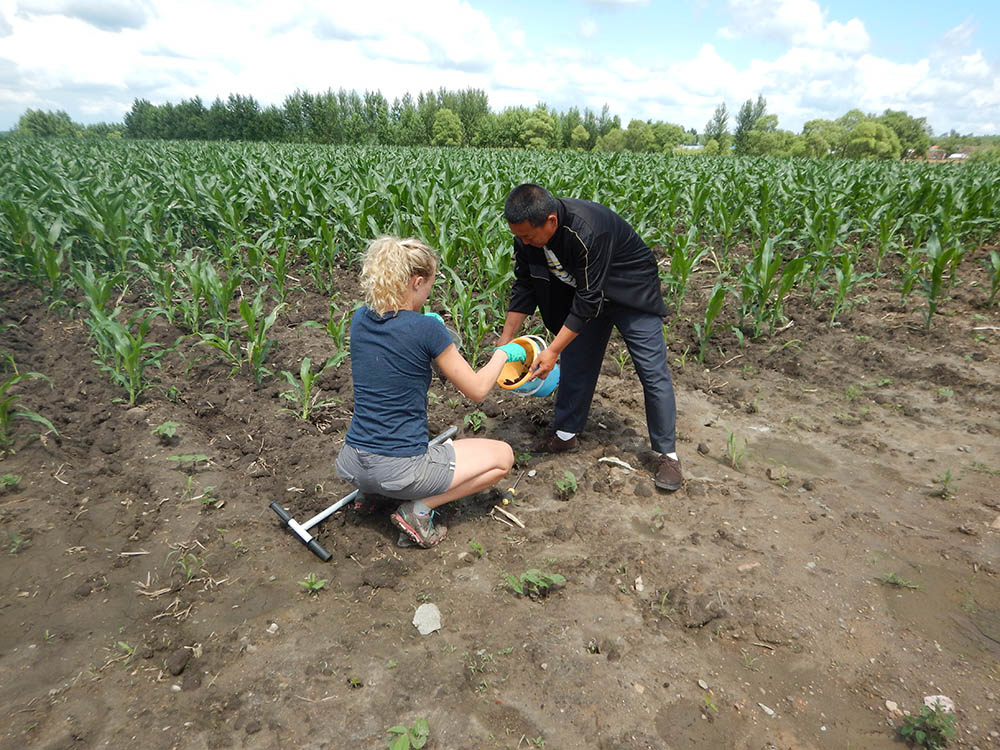What I actually do
Add Summary

July 5, 2016
Anna Herzberger is an MSU Center for Systems Integration and Sustainability doctoral student doing research in the Heilongjiang Province in northeastern China. She hails from the farmlands of Virginia, Ill.
So if you remember from previous blogs, my research project is attempting to find differences is in the soil-microbial community between corn, rice (grasses) and soy (a legume). Global soybean trade, specifically soybeans from Brazil and the USA, are being imported by China; these imports are cheaper than domestically produced soybeans, thus driving out China’s domestic soybean production. Areas that were originally planted with soy are being converted to rice and corn, as they are more profitable crops. In order to identify these changes, our research team is traveling around Heilongjiang, the far northeastern province, surveying farmers and sampling their soil.
We wake up around 6 a.m. Thanks to China having no time zones the sun rises along with the people arou nd 3 a.m., so really we wake up between 3 and 6 a.m.
nd 3 a.m., so really we wake up between 3 and 6 a.m.
We pack quickly. I only have a book bag of clothes so that doesn’t take long but the soil samples and sampling equipment are awkward, bulky and dirty. After playing charades with the hired Chinese driver who speaks no English, we usually come to an agreement on how the car should be packed. Lastly, we grab some steamed buns or hard-boiled eggs to satisfy our appetites until lunch. Then we are off to drive to the first village that can best be described as a not-so-fun amusement ride. The roads are riddled with potholes, two lanes always serve as three and blaring of horns replace the non-existent traffic laws. Once we reach are destination I am flooded with a sense of relief that didn’t end up in a head on collision or in a ditch.
At the village my colleagues begin to survey the farmers, since my Chinese skills are rudimentary I wait patiently in the car (as I am now while writing this blog). Once the surveys are complete and a few friendly farmers have agreed to allow the tall, pale foreigner with a curly mop atop her head to sample their field we are off to the countryside. I attempt friendly small talk, but it quickly becomes evident that studying Chinese for only a year wasn’t quite enough.
At the field the farmer attempts to explain to me where the boundaries of his field are. This is in serious contrast to the lay out of fields in the U.S. where one farmer owns one field and you can see the boundaries. In China, each field has several farmers’ plots within one field, making it impossible to identify the dimensions of an individual field without the presence of the farmer. After double checking the dimensions, which consist of me walking the perimeter and repeatedly saying “zhege?” (here) and looking to the farmer for approval, we begin the sampling. The farmers may use old seed bags or large rocks to mark the rows that belong to them, which I often replace with field flags so I can more easily observe the perimeter. I always make sure to offer the farmers the flags that I used to mark their perimeter, which is met with gleeful enthusiasm. They seem to marvel in the idea that their rows now stand out in the large field among some many similar plots.
Working with the farmers to complete the sampling is easily the most fun part of my day. They tend to approach me with caution at first but soon become excited by the idea that a foreigner is interested in their soil, often grabbing the soil probe from my hand and doing the sampling for me! I always welcome this gesture, first it is a good feeling that they want to be involved in the process and second, the



 Print
Print Email
Email









